Here are the stories to start the new week...
Be safe out there!
Tom
Plane crash in DeKalb County claims pilot’s life, injures child
by: Ethan Illers
DEKALB COUNTY, Ill. (WGN) – One person has died and a child was injured after a sm
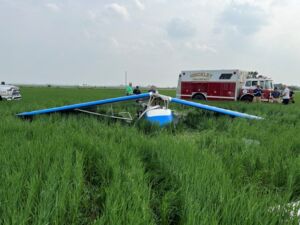
all plane crashed in DeKalb County Saturday afternoon.
The DeKalb County Sheriff’s Office said a single engine 1946 Aeronca 7 AC was carrying a 51-year-old pilot and 3-year-old passenger from Maple Park, Illinois when it crashed into a farm field just west of the airfield.
The pilot was pronounced dead at the scene while the 3-year-old passenger was taken to Northwestern Medicine Kishwaukee Hospital and was later taken to Lurie Children’s Hospital in Chicago in stable condition, according to investigators.
The FAA and NTSB are investigating the cause of the crash.
https://wgntv.com/dekalb/plane-crash-in-dekalb-county-claims-pilots-life-injures-child/
No fatalities reported after skydiving plane crashes in Tennessee, officials say
By Amanda Musa
Several people are receiving medical 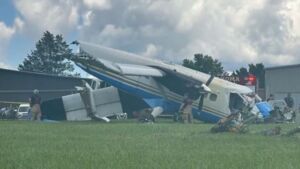 treatment after a skydiving plane with 20 passengers and crew on board crashed in Coffee County, Tennessee, about 60 miles south of Nashville, according to the City of Tullahoma, where the crash occurred Sunday afternoon.
treatment after a skydiving plane with 20 passengers and crew on board crashed in Coffee County, Tennessee, about 60 miles south of Nashville, according to the City of Tullahoma, where the crash occurred Sunday afternoon.
Three people were airlifted to hospitals for medical treatment while one person with serious injuries was transported by ground, according to Lyle Russell, a city spokesperson.
“Other minor injuries were treated by first responders” at the scene, Russell said in a statement to CNN.
No one died in the crash near the Tullahoma Regional Airport, according to Russell who added no one on the ground was injured.
Highway patrol video shows damage to the plane’s tail, which appears to have broken off along with other parts of the aircraft. Yellow caution tape is seen in the video blocking off the area where the plane came to rest while officials investigate the scene.
The plane – a DeHavilland DH-6 Twin Otter – departed Tullahoma Airport at approximately 12:30 p.m. local time Sunday.
The Federal Aviation Administration is investigating the crash, according to Russell.
https://edition.cnn.com/2025/06/08/us/coffee-county-tennessee-plane-crash
2 taken to hospital after small plane crash in Chilliwack
By Alyssa Conti
CHILLIWACK — A couple of patients have 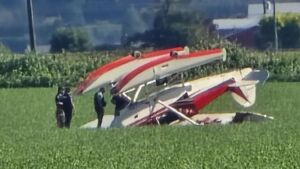 been taken to hospital after a small plane crash in Chilliwack Saturday afternoon (Jun. 7).
been taken to hospital after a small plane crash in Chilliwack Saturday afternoon (Jun. 7).
At around 4:30 p.m., emergency crews were called out to Highway 1 and Prest Road after a Bearhawk float plane with two passengers crashed into a nearby field.
Two RCMP vehicles and Chilliwack Fire attended, while three ambulances and a helicopter were paged for launch. The helicopter was cancelled shortly after.
The fire department cleared the scene before 5 p.m., and police have since taken control of the scene.
Naxos: Olympic Air aircraft makes emergency landing due to engine fire
Naxos Times
Disruption at Naxos airport – Olympic Air 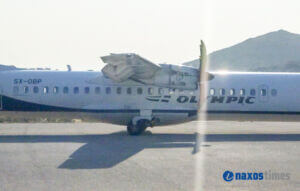 plane suffers engine failure and fire during takeoff. All passengers are safe
plane suffers engine failure and fire during takeoff. All passengers are safe
An Olympic Air plane made an emergency landing at Naxos airport on Saturday afternoon, following a fire that broke out in one of its engines during taxiing for takeoff.
According to information from naxostimes.gr, the incident occurred while the plane was gaining speed and preparing to take off. One of its engines caught fire and an explosion followed, forcing the captain to immediately make an emergency landing.
The aircraft landed safely and all passengers disembarked without injury. At this time, the plane remains at Naxos airport.
Olympic Air, according to the same information, will immediately inform passengers about how they will continue their journey, via email. 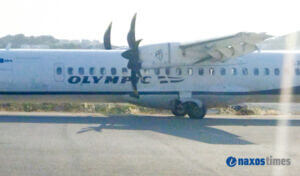
Naxostimes is monitoring the issue and will return with more information.
AEGEAN's announcement in detail:
AEGEAN informs that flight OA 017 operated by Olympic Air, from Naxos to Athens with 45 passengers and 4 crew members, shortly after takeoff showed signs of fire in one of the aircraft's engines. In accordance with company procedures, the captain decided to return the aircraft to Naxos airport and informed the airport of the appropriate measures. The aircraft landed, the captain proactively activated the evacuation procedure and the passengers disembarked safely.
The company is sending a new aircraft to get passengers to their destination.
Νάξος: Αναγκαστική προσγείωση αεροσκάφους της Olympic Air λόγω φωτιάς σε κινητήρα
Small aircraft makes emergency landing on Highway 11
By Julianna Balsamo
A small aircraft was forced to make an 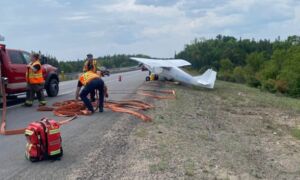 emergency landing on Highway 11 North in Perry Township on Friday.
emergency landing on Highway 11 North in Perry Township on Friday.
The incident occurred just after 4 p.m., prompting a response from the Almaguin Highlands Ontario Provincial Police and local emergency crews.
Officials say the aircraft landed on the highway due to a mechanical failure. Fortunately, no injuries were reported in the midst of this incident.
It is unclear what caused the mechanical failure.
https://www.ctvnews.ca/barrie/article/small-aircraft-makes-emergency-landing-on-highway-11/
NTSB Final Report: Evektor Aerotechnik EV97
At The Time Of The Accident The Wind Was 140° At 11 Knots, Gusting To 19 Knots
Location: Midland, Texas Accident Number: CEN24LA289
Date & Time: July 29, 2024, 13:30 Local Registration: N916SR
Aircraft: Evektor Aerotechnik EV97 Aircraft Damage: Substantial
Defining Event: Loss of control on ground Injuries: 2 None
Flight Conducted Under: Part 91: General aviation - Personal
Analysis: According to the pilot, she was on a multi-day cross-country flight in the experimental light sport airplane. Two days before the accident, she stopped for fuel and had the brakes serviced because she said the brakes were sticking while taxiing; she reported that the brakes worked fine after the maintenance was performed.
The pilot continued the cross-country flight and stopped at another airport to refuel. The pilot reported that while taxiing from the fuel area to the runway, the right brake became inoperative, and the airplane veered off the taxiway and into the grass. The right landing gear strut broke, and the right wing sustained substantial damage. The brake system and the steering linkage for the nose landing gear were examined. No anomalies were noted that would have precluded normal operation of the brakes or steering.
The investigators were unable to replicate the brake anomaly.
At the time of the accident the wind was 140° at 11 knots, gusting to 19 knots. It is likely that during the taxi the pilot did not properly account for the gusting wind and lost directional control.
Probable Cause and Findings: The National Transportation Safety Board determines the probable cause(s) of this accident to be -- The pilot’s failure to maintain directional control during taxi due to strong wind gusts.
FMI: www.ntsb.gov
NTSB Final Report: Avid Magnum
Pilot’s Failure To Maintain Clearance From The Water While Maneuvering In Low Visibility Conditions
Location: Beaver Island, Michigan Accident Number: CEN23FA257
Date & Time: June 23, 2023, 08:44 Local Registration: N103DG
Aircraft: Avid Magnum Aircraft Damage: Substantial
Defining Event: Controlled flight into terr/obj (CFIT) Injuries: 1 Fatal, 1 Minor
Flight Conducted Under: Part 91: General aviation - Personal
Analysis: During a local personal sightseeing flight, the pilot was maneuvering the airplane to see a lighthouse on a remote island. Although he reported that he had good visibility and that the water was flat, the airplane inadvertently impacted the surface of the lake. The pilot regained consciousness in the water but had no recollection of the accident. The airplane was submerged in 20 ft of water. A postaccident examination of the airplane revealed that both wings, the floats, and the lower fuselage exhibited significant aft crush damage consistent with a nose low, left-wing low impact with the water. An examination of the engine and airframe revealed no mechanical anomalies that would have precluded normal operations.
According to a surface observation about 6 miles southeast of the accident site, visual meteorological conditions prevailed. Satellite imagery for the accident site indicated cloud cover and lower visibility over most of the lake due to wildfire smoke. The first responders reported that about 15 minutes after the accident there was a lack of contrast on the horizon with smoke, haze, and calm seas, with no discernable horizon visible. The pilot of a rescue helicopter that arrived at the accident site about 30 minutes after the accident confirmed that the smoke and haze, combined with no wind and very calm water, made it impossible to determine where the sky and water met. There was no record that the pilot obtained a weather briefing before the flight.
Given the condition of the airplane and the visibility conditions at the time of the accident, it is likely that the pilot was not able to discern between the water and the horizon due to the smoke, haze, and the calm waters which resulted in the inadvertent descent into the water.
Probable Cause and Findings: The National Transportation Safety Board determines the probable cause(s) of this accident to be -- The pilot’s failure to maintain clearance from the water while maneuvering in low visibility conditions due to smoke and haze.
FMI: www.ntsb.gov
NTSB Prelim: Seamax Aircraft LTDA Seamax M-22
The Airplane Appeared To Struggle To Maintain The Climb... The Wings Were Rocking Back And Forth As The Airplane Climbed
Location: Dahlgren Center, VA Accident Number: ERA25LA203
Date & Time: May 17, 2025, 16:00 Local Registration: N154RL
Aircraft: Seamax Aircraft LTDA Seamax M-22 Injuries: 1 Serious
Flight Conducted Under: Part 91: General aviation - Personal
On May 17, 2025, about 1600 eastern daylight time, a special light sport amphibious Seamax M-22 airplane (File Photo, below), N154RL, was substantially damaged when it was involved in an accident near Dahlgren, Virginia. The pilot sustained serious injuries. The airplane was being operated as a Title 14 Code of Federal Regulations Part 91 personal flight.
According to family, the pilot and passenger departed from his home-based airport near Fredericksburg, Virginia, then flew to Dahlgren, Virginia for an amphibious water landing on the Potomac River. Shortly after dropping off his passenger, the pilot taxied out for an attempted takeoff.
Surveillance footage from 4 separate cameras located at various sites on shore, showed the airplane during the initial takeoff run on a west to east track. After what appeared to be a normal takeoff run, the airplane rotated and lifted off, but during the initial climb, the airplane appeared to struggle to maintain the climb. The wings were rocking back and forth as the airplane climbed to about 75 to 100 ft above the water surface. The airplane then made a left turn to the north; shortly after, the left wing dropped, and the airplane abruptly descended in a left spiral until impacting the water. According to emergency personnel, the airplane floated briefly, and the pilot was rescued. A brief engine compartment fire ensued.
Post accident examination of the wreckage by the NTSB Investigator revealed the airplane had impacted the water in a steep nose down attitude. The water was about 8 ft deep at the point of impact. There was substantial damage to the airframe; the left wing was impact separated, the cockpit and fuselage were fractured and crushed in multiple locations. The empennage remained attached by control rods and cables. All flight control surfaces remained attached to their respective positions and were manually manipulated with corresponding cable movement. All fractures in the flight control cables had a “broomstraw” appearance indicative of overload.
The engine, mounted on top of the airframe in a pusher configuration was exposed to fire near the propeller side of the engine, however, the engine was largely intact, and most thermal damage was limited to plastics and wiring insulation. Engine crankshaft and valve action continuity was confirmed. The spark plugs showed normal wear. The engine appeared well lubricated, and the oil tank (dry sump forced lubrication system) was intact and full of oil.
The 3-bladed composite propeller remained attached to the hub and reduction gearbox assembly, and it was manually rotated without any hinderance. One of the blades was destroyed by fire. The opposing blades remained intact. During manual operation of the propeller, bay water was forced out of the cylinders and the air filter assembly.
The engine fuel line adjacent to the cylinders was examined and about 5-ounces of liquid with the smell and color of avgas was observed; it was free of water or other contaminants. The engine control unit was retained for further examination and download.
FMI: www.ntsb.gov
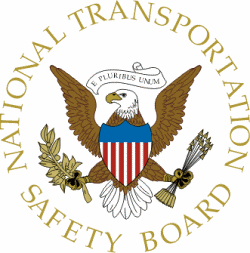
Today in History
30 Years ago today: On 9 June 1995 Ansett New Zealand flight 703, a DHC-8-100, impacted a hillside while on approach to Palmerston North Airport, New Zealand, killing 4 occupants; 17 survived the accident.
| Date: | Friday 9 June 1995 |
| Time: | 09:22 |
| Type: | de Havilland Canada DHC-8-102 |
| Owner/operator: | Ansett New Zealand |
| Registration: | ZK-NEY |
| MSN: | 055 |
| Year of manufacture: | 1986 |
| Total airframe hrs: | 22154 hours |
| Cycles: | 24976 flights |
| Engine model: | P&W Canada PW120A |
| Fatalities: | Fatalities: 4 / Occupants: 21 |
| Other fatalities: | 0 |
| Aircraft damage: | Destroyed, written off |
| Category: | Accident |
| Location: | 16 km E of Palmerston North - New Zealand |
| Phase: | Approach |
| Nature: | Passenger - Scheduled |
| Departure airport: | Auckland International Airport (AKL/NZAA) |
| Destination airport: | Palmerston North Airport (PMR/NZPM) |
| Investigating agency: | TAIC |
| Confidence Rating: | Accident investigation report completed and information captured |
Narrative:
Ansett New Zealand flight 703, a DHC-8-100, impacted a hillside while on approach to Palmerston North Airport, New Zealand, killing 4 occupants; 17 survived the accident.
At 08:17 Ansett New Zealand Flight 703 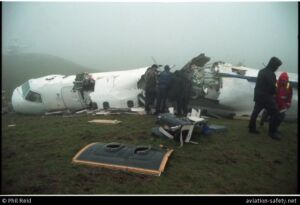 departed Auckland (AKL) as scheduled bound for Palmerston North (PMR).
departed Auckland (AKL) as scheduled bound for Palmerston North (PMR).
To the north of Palmerston North the pilots briefed themselves for a VOR/DME approach to runway 07 which was the approach they preferred. Subsequently Air Traffic Control specified the VOR/DME approach for runway 25, due to departing traffic, and the pilots re-briefed for that instrument approach. The IMC involved flying in and out of stratiform cloud, but continuous cloud prevailed during most of the approach. The aircraft was flown accurately to join the 14 nm DME arc and thence turned right and intercepted the final approach track of 250° M to the Palmerston North VOR. During the right turn, to intercept the inbound approach track, the aircraft's power levers were retarded to 'flight idle' and shortly afterwards the first officer advised the captain ".... 12 DME looking for 4000 (feet)". The final approach track was intercepted at approximately 13 DME and 4700 feet, and the first officer advised Ohakea Control "Ansett 703" was "established inbound". Just prior to 12 miles DME the captain called "Gear down". The first officer asked him to repeat what he had said and then responded "OK selected and on profile, ten - sorry hang on 10 DME we're looking for four thousand aren't we so - a fraction low". The captain responded, "Check, and Flap 15". This was not acknowledged but the first officer said, "Actually no, we're not, ten DME we're..... (The captain whistled at this point) look at that". The captain had noticed that the right hand main gear had not locked down: "I don't want that." and the first officer responded, "No, that's not good is it, so she's not locked, so Alternate Landing Gear...?" The captain acknowledged, "Alternate extension, you want to grab the QRH?" After the First Officer's "Yes", the captain continued, "You want to whip through that one, see if we can get it out of the way before it's too late." The captain then stated, "I'll keep an eye on the airplane while you're doing that."
The first officer located the appropriate "Landing Gear Malfunction Alternate Gear Extension" checklist in Ansett New Zealand's Quick Reference Handbook (QRH) and began reading it. He started with the first check on the list but the captain told him to skip through some checks. The first officer responded to this instruction and resumed reading and carrying out the necessary actions. It was the operator's policy that all items on the QRH checklists be actioned, or
proceeded through, as directed by the captain. The first officer started carrying out the checklist. The captain in between advised him to pull the Main Gear Release Handle. Then the GPWS's audio alarm sounded. Almost five seconds later the aircraft collided with terrain. The Dash 8 collided with the upper slope of a low range of hills.
CAUSAL FACTORS: "The captain not ensuring the aircraft intercepted and maintained the approach profile during the conduct of the non-precision instrument approach, the captain's perseverance with his decision to get the undercarriage lowered without discontinuing the instrument approach, the captain's distraction from the primary task of flying the aircraft safely during the first officer's endeavours to correct an undercarriage malfunction, the first officer not executing a Quick Reference Handbook procedure in the correct sequence, and the shortness of the ground proximity warning system warning."
